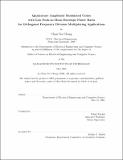Quadrature amplitude modulated codes with low peak-to-mean envelope power ratio for orthogonal frequency division multiplexing applications
Author(s)
Chong, Chan Vee, 1975-
DownloadFull printable version (973.5Kb)
Other Contributors
Massachusetts Institute of Technology. Dept. of Electrical Engineering and Computer Science.
Advisor
Vahid Tarokh.
Terms of use
Metadata
Show full item recordAbstract
Orthogonal Frequency Division Multiplexing (OFDM) has been adopted as the modulation technique for many of the next generation wireless broadband multimedia communications systems, for example, Digital Audio Broadcasting (DAB), terrestrial Digital Video Broadcasting (DVB), and the wireless local area network (LAN) standards HIPERLAN/2, and IEEE 802.11a. One problem inherent in plain vanilla OFDM is that its signal envelope fluctuates greatly with very high power peaks, necessitating the use of inefficient and complex linear power amplifiers. Solutions to the high peak-to-mean envelope power ratio (PMEPR) problem include signal processing techniques such as clipping, peak windowing, and peak cancellation, as well as coding techniques, i.e. using codes to ensure that only those OFDM signals with low PMEPR are transmitted. It is well known that using codewords generated by mapping binary Golay complementary sequences into BPSK yields OFDM signals with low PMEPR. Frank, Sivaswamy, and others have extended the results of Golay from binary phase shift keying (BPSK) to other PSK constellations. Recently, Davis and Jedwab presented a code structure for these PSK complementary sequences using cosets of first-order Reed-Muller codes in second-order Reed-Muller codes. This yielded OFDM codes using PSK modulation which could be encoded and decoded using well-understood algorithms for Reed-Muller codes. This thesis investigates the properties of quadrature amplitude modulated (QAM) OFDM signals with low PMEPR, focusing in particular on signals based on 4-QAM and 16-QAM constellations. We construct and prove new code structures for sequences in 4-QAM and 16-QAM that result OFDM signals with low PMEPR. Many practical implementations of OFDM use QAM constellations instead of PSK constellations. Thus the codes presented could be used to design pilot symbols for actual OFDM systems, as well as be employed in practical OFDM applications requiring both low PMEPR as well as low computational complexity.
Description
Thesis (S.M.)--Massachusetts Institute of Technology, Dept. of Electrical Engineering and Computer Science, 2001. Includes bibliographical references (p. 83). This electronic version was submitted by the student author. The certified thesis is available in the Institute Archives and Special Collections.
Date issued
2001Department
Massachusetts Institute of Technology. Department of Electrical Engineering and Computer SciencePublisher
Massachusetts Institute of Technology
Keywords
Electrical Engineering and Computer Science.